
We live in the internet age, and almost everyone has a wireless router in their homes, helping families stay connected at all times. While Wi-Fi is a frequent term in our vocabulary, the names of the different wireless networking standards are challenging to understand and even pronounce. That is because they have complicated names invented by network engineers and corporations. Do you know what 802.11ax is? What about 802.11ac or 802.11n? To help you, I explain these terms and share the basics you need to know about each Wi-Fi standard, how they differ, and the real-life performance each of them delivers. Read this article to find the information you need:
What is 802.11n or what is Wi-Fi 4?
802.11n, under its full name IEEE 802.11n-2009, is an old wireless networking standard, announced in its draft format in 2007, and finalized and published in 2009. 802.11n is also referred to as Wi-Fi 4, and it’s the first standard to allow the use of two radio frequency bands: 2.4 GHz and 5 GHz. The 5 GHz band is an optional component of Wi-Fi 4, and manufacturers ignored it on many of their routers to keep costs down. However, 5 GHz was available as a differentiating feature on the more premium routers of the 802.11n era, like the ASUS RT-N56U.

ASUS RT-N56U is one of the most popular 802.11n routers
802.11n is also the first wireless standard to support MIMO (multiple-input-multiple-output) - a technology that uses multiple antennas to transmit more data by combining independent data streams. MIMO was a revolutionary step in the evolution of wireless networking standards. It allowed major improvements in how data was transmitted between routers or access points and network clients in the standards that followed 802.11n.
On modern Wi-Fi 6 routers, 802.11n is used for backward compatibility. Therefore, it’s no longer turned on by default as the main standard for the 2.4 GHz band. However, you can use this standard by choosing 802.11b/g/n mixed as the operation mode of your router for the 2.4 GHz band. You can also set the channel width to 20 or 40 MHz (I recommend the latter for higher speed).
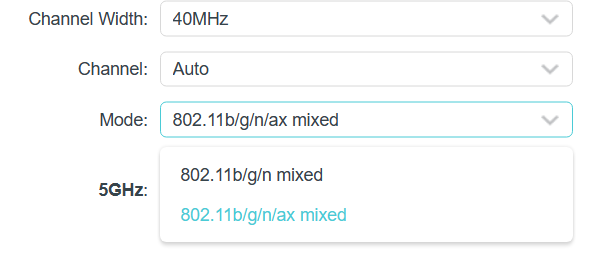
Wi-Fi 6 routers still use 802.11n for the 2.4 GHz band
What is 802.11ac or what is Wi-Fi 5?
802.11ac, IEEE 802.11ac, or Wi-Fi 5 is a wireless standard developed between 2008 and 2013 and finalized in late 2013. It aimed to provide high-throughput connectivity across the 5GHZ band. Wi-Fi 5 improves the earlier 802.11n wireless standard and the MIMO technology introduced by Wi-Fi 4 with a major enhancement named MU-MIMO. MU-MIMO gives multiple devices the ability to transmit to several clients simultaneously instead of just one or to transfer data to a network client using multiple data streams at once, thus increasing the speed of the transfer.
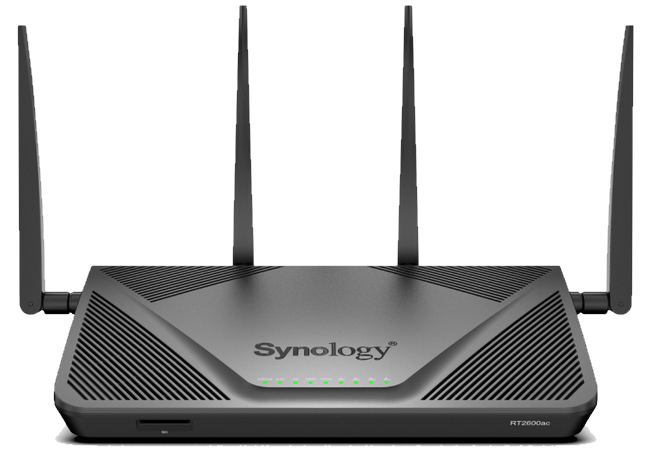
Synology RT2600ac is one of the best 802.11ac routers
802.11ac devices were split into two categories, called 802.11ac Wave 1 and Wave 2. The products sold as part of the 802.11ac Wave 1 were introduced in 2013, while the ones in Wave 2 were introduced in 2016. Wave 2 was an improved version of the 802.11ac standard and allowed routers to have higher throughput and add support for MU-MIMO: while Wave 1 routers could provide bandwidth of up to 1.3 Gbps, the ones in Wave 2 delivered bandwidth of up to 2.3 Gbps.
Wi-Fi 5 allows the use of 20 MHz, 40 MHz, 80 MHz, and 160 MHz channels. However, 160 MHz became commonplace in consumer routers only with the launch of Wi-Fi 6, and most 802.11ac offered channels of up to 80 MHz.
While you can still buy 802.11ac routers, they are dated for today’s consumer expectations and needs. Such routers tend to have older hardware and can handle networks with fewer connected devices than modern Wi-Fi 6 routers. Wi-Fi 5 is available on all modern routers for backward compatibility purposes. If you want to set 802.11ac as the main standard for the 5 GHz band on your new Wi-Fi 6 router, choose 802.11a/n/ac mixed as the default operating mode.
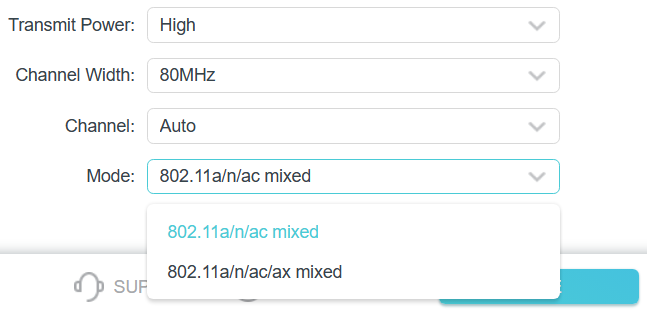
Wi-Fi 6 routers also use the 802.11ac standard on the 5 GHz band
What is 802.11ax or what is Wi-Fi 6?
802.11ax or IEEE 802.11ax, officially marketed by the Wi-Fi Alliance as Wi-Fi 6 and Wi-Fi 6E, is a standard for wireless networks that helps improve network operation in dense environments. This standard was designed to operate using the 2.4 GHz, 5 GHz, and 6 GHz bands. Wi-Fi 6 is the first standard to add a 6 GHz band, which aims to enhance the throughput per area in environments with a high density of connected devices. The most important feature of 802.11ax is orthogonal frequency-division multiple access or OFDMA, which is equivalent to cellular technology applied to Wi-Fi networks. It can operate using 20, 40, 80, and 160 MHz channels, with the key difference being that 160 MHz channels are widely adopted on Wi-Fi 6 routers for the consumer market, unlike on Wi-Fi 5 routers. Only lower-end Wi-Fi 6 routers lack 160 MHz channels.

Wi-Fi 6 routers finally unlocked the 160 MHz channel bandwidth
Another key feature introduced by Wi-Fi 6 is Target Wake Time. It allows network clients like smartphones and other mobile devices to wake up only when they have data to transmit to the router or access point instead of being active permanently, leading to important energy savings across the network. Lastly, security improved in 802.11ax by supporting the much more secure WPA3 encryption standard for password security.

Target Wake Time optimizes energy consumption on your mobile devices
The initial version of the Wi-Fi 6 standard was released in late 2019. Then, in January 2021, Wi-Fi 6 was further extended by the Wi-Fi 6E standard, which added a new 6 GHz band. More details in this article: What is Wi-Fi 6E? How does it compare to Wi-Fi 6?
While Wi-Fi 6E allows routers to manage more devices and offer more bandwidth than ever with less interference, Wi-Fi 6E routers and mesh Wi-Fi systems tend to be expensive. Because of that, and the fact that you need Wi-Fi 6E compatible devices for the 6 GHz band, this standard’s adoption is likely to be limited, at least in the consumer space.
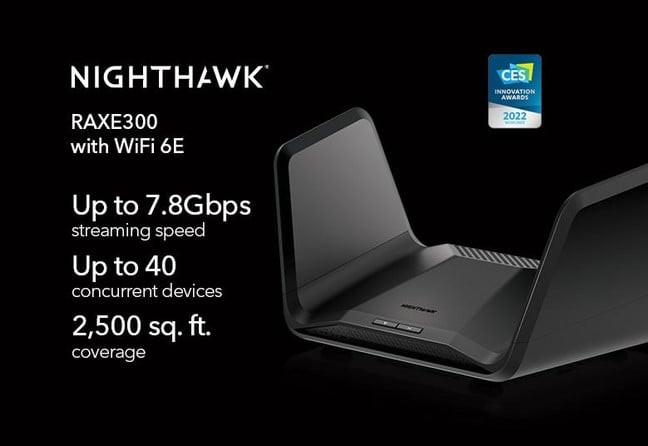
NETGEAR Nighthawk AXE7800 WiFi Router (RAXE300)
To make things even more confusing, a Wi-Fi Certified 6 Release 2 is available as of January 2022, bringing new features that support increasing device and traffic density to deliver greater performance. One way this is achieved is by fine-tuning the MU-MIMO technology to work in an uplink direction. This means that it can be used by a router or access point to receive data from multiple clients simultaneously, not just to send data to them. Release 2 also improves the power management features of the initial release of Wi-Fi 6 to allow for extended sleep times, specific “wake up” times for transmitting data across the network, and other technical improvements.
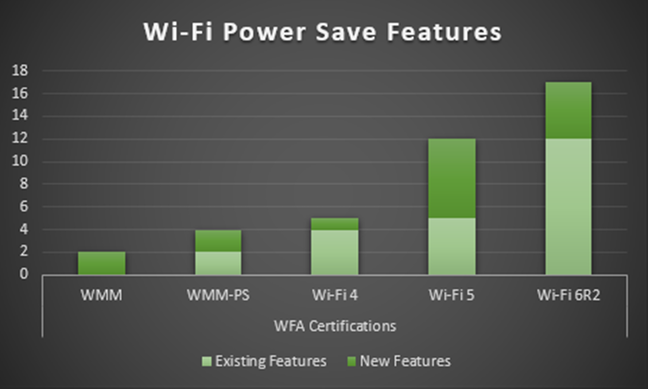
Wi-Fi Certified 6 Release 2 - Wi-Fi power saving features
When did 802.11ax, 802.11ac, and 802.11n become Wi-Fi 6, Wi-Fi 5, and Wi-Fi 4?
Ever since I started testing wireless routers in 2012, I disliked the naming conventions used by the Wi-Fi Alliance for their networking standards. They are very technical and impossible to understand by normal people with no technical knowledge. Years later, the organization understood the problem, and on October 3rd, 2018, it announced a new naming convention to make it easier for people to identify what’s what. Their thinking is that Wi-Fi, followed by a number, is easy to remember, and that’s true. Also, the higher the number, the newer and better the standard. Here’s how the naming of wireless standards has changed as of 2018:
- 802.11n was turned into Wi-Fi 4
- 802.11ac was renamed to Wi-Fi 5
- 802.11ax has been named Wi-Fi 6 since its launch
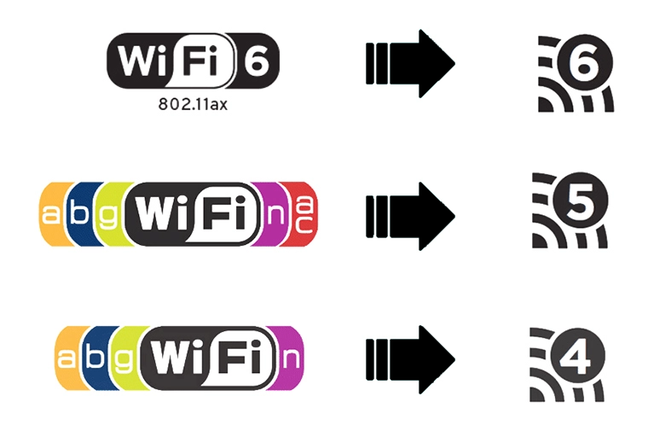
How wireless standards were renamed
Wi-Fi 1, Wi-Fi 2, and Wi-Fi 3 do not exist as brands because they would have represented the old 802.11a, 802.11b, and 802.11g wireless standards (released in 1999 and 2003), which are no longer used by modern networks and devices.
As of 2024, we will also have a new Wi-Fi 7 standard, or 802.11be, which will bring interesting developments and features. If you’re curious how it will compare to the existing standards, check the table below, which presents a technical summary, courtesy of TP-Link.
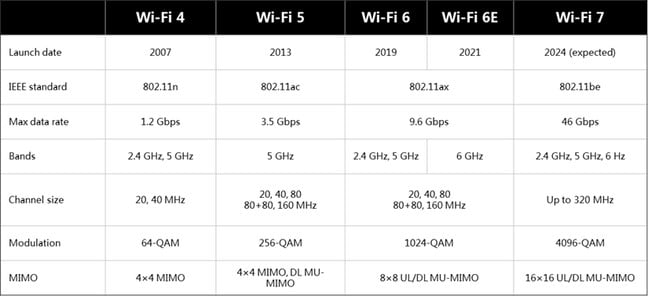
The future brings Wi-Fi 7
I will return with a detailed article about Wi-Fi 7 when it becomes available more widely, and I get access to routers and laptops with Wi-Fi 7, to test and understand this standard more thoroughly through personal experience, not just dry theory.
Real-life performance: 802.11ax vs. 802.11ac vs. 802.11n
If you read the specifications of each Wi-Fi standard and the maximum theoretical speed that each can achieve, you might believe you’ll get some outstanding speeds for your Wi-Fi. However, the real-life experience differs greatly from what the maximum theoretical data rates tell us. To better understand what to expect and see just how fast Wi-Fi 6 is versus Wi-Fi 5 and Wi-Fi 4, I took two TP-Link routers and made a detailed performance comparison: Wi-Fi 6 vs. Wi-Fi 5 vs. Wi-Fi 4 on TP-Link routers.
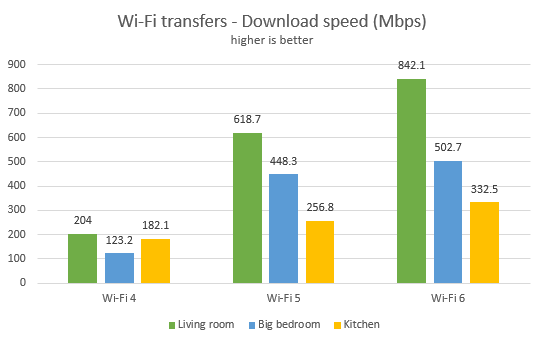
Wi-Fi 6 vs. Wi-Fi 5 vs. Wi-Fi 4 on TP-Link routers
While routers from other brands will give you a slightly different experience, this analysis is representative of the actual speed differences people are likely to get in their homes and offices.
Do wireless routers use one or more Wi-Fi standards?
All modern wireless routers emit their signal using multiple Wi-Fi standards simultaneously. For example, Wi-Fi 6 routers emit their signal on the 2.4 GHz frequency band using both 802.11ax and 802.11n simultaneously for compatibility purposes. This way, they ensure that older devices in your home can connect, even though they are incompatible with Wi-Fi 6. The same is true for the 5 GHz band; most routers emit their wireless signal using 802.11ac and 802.11ax simultaneously to provide maximum compatibility with the devices in your home.

Wi-Fi 6 routers use both 802.11ax and 802.11n on the 2.4 GHz band
You can set most routers to use only one standard on each of their bands. For example, I can disable 802.11ax on the 2.4 GHz band on just about any ASUS Wi-Fi 6 router and use only 802.11n to emit their signal. If you have a quad-band router like the ASUS ROG Rapture GT-AXE16000 or a tri-band router, you can set each band to use a completely different standard:
- Wi-Fi 4 on the 2.4 GHz band for maximum compatibility with old devices that don’t work with Wi-Fi 6;
- Wi-Fi 5 on the first 5 GHz that this router provides. Again, the reason is to maximize compatibility for older devices working with the 802.1ac standard but not 802.11ax.
- Wi-Fi 6 on the second 5 GHz band, so that newer devices can take advantage of this standard’s speed and bandwidth improvements.
- Wi-Fi 6E on the 6 GHz band for devices that work with this standard.
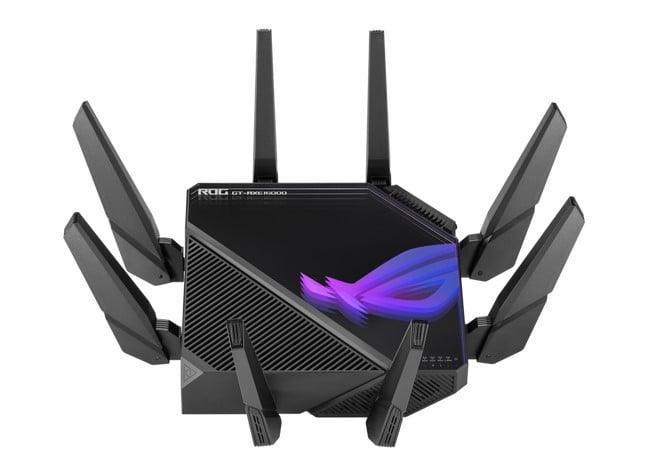
ASUS ROG Rapture GT-AXE16000 - a powerful quad-band Wi-Fi 6E router
What kind of router do you have?
Now you know all the basics about the different wireless standards used today, how they were named and subsequently renamed, and what they offer compared to the previous versions. Before closing this article, let me know if you have any questions left unanswered. I’m also curious about the router you’re using in your home: is it an older Wi-Fi 5 router? Or is it a newer Wi-Fi 6 or Wi-Fi 6E router? Comment using the options below, and let’s discuss.






